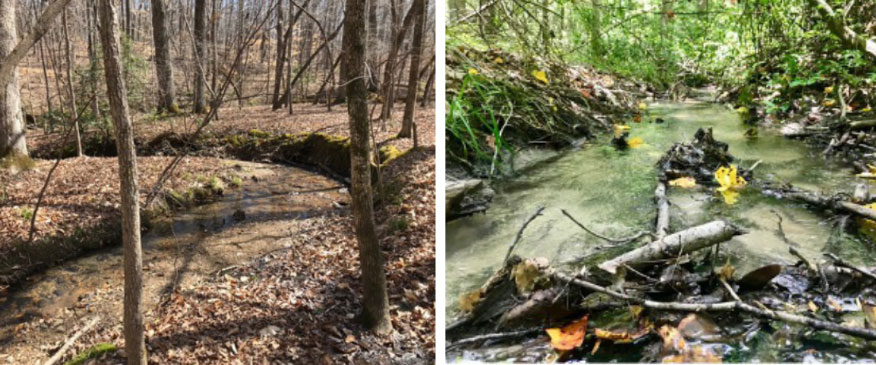The Water Log: March 2023
March 30th, 2023
By Erika Hollis
Happy Spring from the Clean Water Team!
We are all thrilled to see some warmer weather and longer, sunnier days. With spring in the air, many of us can now get outside, push up our sleeves, and get to work in the yard. For some of us in the Upstate, there are waterbodies like streams, rivers, lakes, and wetlands that might run through our property or nearby areas. As we tend to the health of our lawns, plants, and trees this spring, we might also wonder if the streams on our property or nearby are healthy, too.
Read on to learn about what to look for when assessing the health of your stream and some helpful tips if you want to do some minor repairs to stream banks to enhance wildlife habitat and improve water quality in your community.
Warmly,

Erika Hollis
Clean Water Director
Upstate Forever
Healthy Streams
Healthy streams provide countless benefits to our communities and surrounding ecosystems. These benefits include abundant recreational opportunities such as fishing, boating, and swimming. Healthy streams also help to reduce downstream flooding, increase property values, and protect drinking water sources. In fact, surface water from streams, rivers, and lakes provides 3.6 million residents of South Carolina with drinking water.
So, what makes a stream healthy? Floodplain connection is a critical characteristic of a healthy stream system regardless of stream shape or size. A floodplain is a low-lying area adjacent to the stream where water can spread out and slow down during high flow events. When humans alter banks and cut streams off from their floodplains, rain events can cause more water to flow down the stream at higher velocities, which can exacerbate erosion and lead to dangerous flooding conditions.
A floodplain that maintains its connection to a stream will help provide flood protection to homes and businesses by allowing the stream to expand and contract naturally. In the floodplain, water infiltrates back into the soil and recharges groundwater supplies, an important source of freshwater for humans. Floodplains also work as filters, protecting aquatic habitat by allowing sediment and nutrients to settle out rather than accumulating in streams.
In addition to floodplain connection, other characteristics of healthy streams include:
- A stream channel that meanders; the bends and curves help to slow water as it travels downstream.
- A stream channel containing fallen logs and leaves creates habitat for aquatic organisms, the base of the food chain.
- Riparian buffers comprised of native plants adapted to withstand fluctuations in temperature, water levels, and sunlight.

A healthy, meandering stream found in the Upper Broad River Watershed (left). A small headwater stream in the Catawba Watershed has a diversity of in-stream materials, including large woody debris and leaf litter (right).
Unhealthy Streams
Erosion of stream banks and stream channels is an indicator of an unhealthy stream. Signs of erosion include exposed roots, vertical slopes, and slumping banks. Often, these streams have been straightened or channelized, which causes water velocity to increase, adding stress to stream banks, thus causing them to cave in on themselves. Eroding banks can result in property loss for residents and an increased risk for community flooding.
Erosion of stream banks increases the amount of sediment in streams. This excess sediment can damage and degrade aquatic habitats by clogging the gills of macroinvertebrates and fish, increase water temperatures by absorbing sunlight, and fill in spaces used for habitat and spawning. Furthermore, harmful pollutants such as bacteria, pesticides, and fertilizers bind to sediment particles and degrade water quality when entering a stream.

Erosion surrounding sediment has exposed the roots of the streamside tree (left).
Channelized streams can lead to downstream flooding and erosion (right).
How to address Unhealthy Streams
There are a variety of approaches to addressing unhealthy streams, but first one needs to distinguish between stream bank repair practices and stream restoration. Both stream bank repair and stream restoration can provide habitat enhancements and pollution reduction by creating healthy vegetated buffer areas along streams. However, key distinctions between stream restoration and stream repair are the permitting requirements and costs associated.
Stream bank repair provides improved ecological benefits with little or no regulatory permitting, low costs, and limited training. In a stream bank repair project, all the work must occur above the Ordinary High-Water Mark (OHWM) and outside of the stream channel. The OHWM is the line along a stream bank established by water fluctuations and is identified by changes in soil, vegetation, or debris. Any work done below the OHWM and in the stream channels requires permitting from the US Army Corps of Engineers and the South Carolina Department of Health and Environmental Control.

The blue line along this stream indicates the Ordinary High-Water Mark (OHWM).
More severely impaired streams may require a more extensive stream restoration. Stream restoration requires trained engineers, a longer timeline, more permitting, and a much higher price tag. Stream restoration is not limited to stream banks and may include more complicated practices like in-stream structures, channel realignment, and dam removal. If you are unsure whether you need a bank repair or stream restoration, contact your local Clemson Extension Water Resources Agent for guidance.
Stream Bank Repair Practices
- First, adjust the stream bank slope to a 3:1 slope, or three times longer horizontally than vertically. Measure the vertical height from the OHWM to the top of the stream and multiply this measurement by three. The resulting number is the width to which the stream bank should be pulled back starting from the OHWM.
- Prepare the soil and seed. First, remove all invasive plant species in the area that will outcompete the native species. Second, before planting, loosen the soil to promote root infiltration and growth. Then spread a riparian or wetland seed mix that contains native plant species and cover with straw.
-
Install erosion control matting made from coir or coconut fiber to stabilize exposed soil and seeded areas making sure to avoid synthetic material (plastic) that can harm wildlife.
-
Install livestakes. Livestakes are a method of propagation using woody cuttings harvested from specific species of trees and shrubs. The harvest and installation of livestakes should happen when the plants are dormant from November to March.

Until next time . . .
Thank you for signing up to receive The Water Log, Upstate Forever’s email newsletter dedicated to Clean Water news, issues, and information. We appreciate your interest and dedication to safeguarding the Upstate’s water resources.
To learn more about Clemson Extension's Stream Bank Repair program, visit their website.
If you have any questions about this topic or would like to learn about another Clean Water issue in a future edition, please contact me at ehollis@upstateforever.org.

